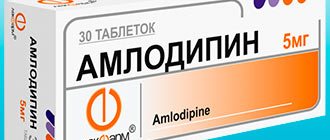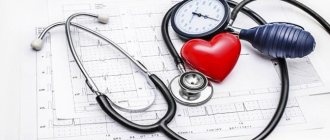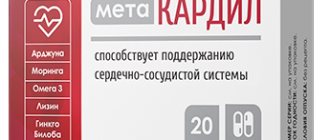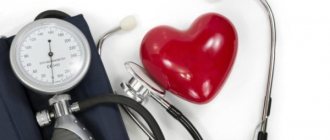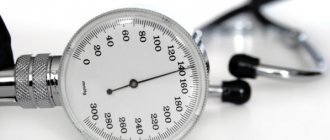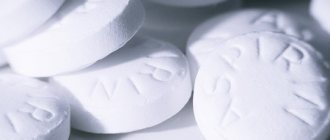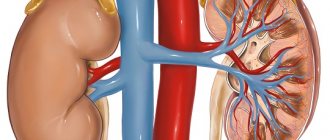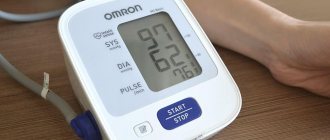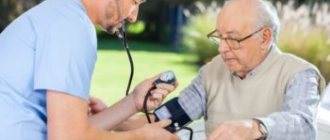Old age is a wonderful time in a person’s life. However, it is associated with multiple ailments, ailments and other health problems. Some of them can be avoided by leading a correct lifestyle, some can be prevented, some can be cured, and others can only be corrected with the help of medications.
Today's article will focus on the problem of high blood pressure and low pulse in an elderly person. We will look at the accompanying symptoms of illness, how to provide first aid, and in general, what to do if such a phenomenon occurs.
What indicators are considered normal?
Before starting treatment for high blood pressure (BP) and low heart rate, it is helpful to become familiar with your normal heart rhythm. Most experts believe that a normal heart rate is 65-85 beats per minute.
This is the heart rate that occurs in many adults. To make sure there are no problems with your heartbeat, pay attention to the time intervals between beats.
If the heart beats at the same time, then the person has no problems with the pulse rate. An excessively rapid heartbeat or long intervals between beats indicate the development of arrhythmias.
The value of normal blood pressure is influenced by various factors, the most important of which are gender and age. A rapid heartbeat is considered normal for babies in the first few months of their life. In this case, the heart rate reaches 135 beats per minute. Within a year, this value drops to one hundred strokes, and after three years - to 95.
By puberty, the heart rate in adults decreases to normal. These changes are due to the fact that during childhood and adolescence, the heart works harder to saturate the body with blood. At the age of 35-40 years, the heart rate gradually increases to 80 beats per minute. In older people aged approximately 60-70 years, this figure increases to 90 heart beats.
Symptoms that require seeing a doctor or calling an ambulance
The list of life- and health-threatening symptoms is quite wide. It is necessary to consult a doctor in any unclear situation; there is no need to be embarrassed about it. False installations can be very expensive.
Among the manifestations that should alert you are:
- Headache of any location and degree of intensity. This is a dangerous manifestation. Indicates a violation of vascular tone and blood circulation.
- Dizziness. Especially of a regular nature. Associated with an attack of bradycardia and arterial hypertension.
- Impaired consciousness. Confusion, inability to think normally. It is dangerous because it indicates an acute cerebrovascular accident.
- Chest pain. They give it to the back and hands.
- Shortness of breath, breathing problems.
- Feeling of unreasonable fear, panic attack.
- Pulse less than 50 beats per minute, weakness, drowsiness, fatigue and a significant decrease in performance even in the morning.
This is only a small part of the manifestations. Others are also possible. In all doubtful cases, you should consult a doctor. This is an axiom that must be remembered.
Deviation from the norm
Each person's heart rate should be within normal limits. However, sometimes heart rate fluctuations exceed the established limits, which leads to deterioration of health. This problem occurs for various reasons. Among them there are pathological and physiological.
The latter are considered the safest, since in this case the pulse returns to normal after half an hour. The most dangerous are pathological factors that cause heart rhythm disturbances, because they are associated with various diseases.
Physiological and pathological factors lead to the following cardiac contraction disorders:
- Increased heart rate. An increase in heart rate to one hundred beats leads to the development of tachycardia. This pathology appears as a result of infectious diseases and abnormalities in the structure of the heart. In rare cases, tachycardia develops with a tumor. If you experience heart palpitations, it is better to consult a doctor to find out the exact cause of the problem.
- Low heart rate. A heart rate less than 60 beats per minute is called bradycardia and can be pathological or functional. Pathological leads to a constant decrease in heart rate, and due to functional heart rate it drops only in the evening.
Is this condition dangerous and why exactly?
Bradycardia (with a pulse less than 50 beats per minute) is somewhat less dangerous than tachycardia, even without a background of high blood pressure (within 140-160 mm Hg). There are four possible consequences.
Heart failure
Occurs relatively rarely with bradycardia. Usually associated with impaired myocardial conduction or changes in the sinus node. Without resuscitation measures, the little man dies. Help needs to be provided urgently.
Heart failure
Associated with a change in the nature of the body’s activities. There is insufficient tissue trophism and, as a result, the inability to adequately supply the body with nutrients and oxygen.
Hypoxia and atrophy of anatomical structures leads to a lot of symptoms. The myocardium also suffers. In the absence of treatment, the next step in the development of pathology is a heart attack.
Heart attack
Cardiac emergency. Associated with acute malnutrition in the heart muscle and tissue death.
During the recovery period, destroyed tissues are replaced by scar tissue (post-infarction cardiosclerosis), and the nature of cardiac activity changes. The consequences remain with a person for life.
Morgagni-Adams-Stokes syndrome
A sharp disturbance in cardiac output as a result of a decrease in heart rate. Accompanied by acute ischemia of cerebral circulation. One of the most dangerous complications of bradycardia. Requires cardiac surgery. Read more about MAS syndrome here.
In addition, the condition is accompanied by unpleasant symptoms, such as decreased performance, constant drowsiness, chest pain, dizziness, etc. So, if your blood pressure is high and your pulse is low, it is a risk. Treatment is needed.
Factors affecting blood pressure
Reasons why people have a low heart rate include problems with blood pressure levels. Therefore, it is important to understand the main factors that influence a person's blood pressure.
Excess weight
Some people develop high blood pressure due to poor diet and obesity. Excess weight increases the load on the body, which leads to problems with the functioning of the heart vessels and other organs responsible for blood circulation. To eliminate hypertension caused by obesity, you will need to change your diet and lose excess weight.
Alcohol
Alcohol abuse negatively affects blood pressure and provokes the development of heart pathologies. It also disrupts the functioning of the nervous system, which impairs blood circulation. To minimize the risk of a heart attack and other dangerous pathologies, you should limit yourself to 50 milliliters per day or completely abstain from alcoholic beverages.
Stressful situations
Regular depression along with stress increases the likelihood of developing high blood pressure. Therefore, to avoid this pathology, it is recommended to avoid stressful situations.
Physical inactivity
Physical inactivity is also one of the factors affecting blood pressure. This pathology reduces muscle tension and leads to weakening of the body. Physical inactivity also causes weight gain and obesity, which also leads to increased blood pressure.
List of necessary examinations for bradycardia due to hypertension
Both the heart and blood vessels are examined. There can be many factors in the development of processes. First of all, you should contact a cardiologist.
If necessary, he will refer the patient to a neurologist or endocrinologist. The complexity and duration of the examination depends on the nature of the disease and the complexity of the situation.
In general, the list of studies looks like this:
- Initial consultation, conversation with the collection of characteristic complaints and anamnestic data. Plays a big role, this is the first step in identifying the root cause of the condition.
- Studying heart rhythm using a stethoscope or automatic blood pressure monitor.
- Measuring blood pressure levels. Required in all cases.
- Daily monitoring using an automatic Holter monitor.
- Electrocardiography with the study of the nature of the heart rhythm and its frequency.
- Study of myocardial conductivity using the introduction of a special sensor. An invasive but informative procedure.
- Assessment of the concentration of hormones of the pituitary gland, adrenal glands and thyroid gland.
- Examination of neurological status.
A complete list of events is required. At the discretion of the doctor, the list may change.
Symptoms of low heart rate and high blood pressure
Rare heartbeats and high blood pressure are most often caused by hypertension, which affects nearly half of all people over 30. The main symptoms of high blood pressure are shortness of breath, nausea with vomiting, ringing in the ears, dizziness and a feeling of tightness in the head. However, if the pathology is accompanied by a low pulse and bradycardia, the following symptoms are added to the above:
- weak and difficult breathing;
- General weakness;
- tingling in the left side of the chest;
- fainting;
- increased sweating;
- abdominal pain.
A low heart rate with high blood pressure will not go away on its own, and without treatment it can lead to serious complications. After the above symptoms of pathology appear, blood flow to the organs will worsen and oxygen starvation will begin to develop. Therefore, if signs of pathology appear, you should immediately consult a doctor so that he can prescribe effective drug treatment.
Associated symptoms
In addition to shortness of breath with high blood pressure and low pulse, dizziness becomes one of the accompanying symptoms. In addition, in such a condition the following accompanying symptoms may be observed:
- headache in the back of the head and temples;
- nausea or vomiting;
- pain and heaviness in the heart area;
- muscle tremors;
- noise in ears;
- general weakness, lethargy;
- convulsions;
- fainting;
- sweating;
- feeling that the heartbeat is stopping.
Before answering the question: “High blood pressure, low pulse: what to do?” It is worth understanding the reasons that led a person to this state.
Features and causes of this condition
Before you begin treatment for slow heartbeat due to high blood pressure, you must understand the causes of this problem. The causes of low heart rate and high blood pressure may depend on a person's gender and age.
Among women
In girls, problems with heart palpitations occur due to disruption of hormone production or dysfunction of the thyroid gland. Pathology also develops as a result of drug use, the side effects of which include heart rhythm problems. Less commonly, problems with pulse and blood pressure are associated with overwork and chronic fatigue.
In men
Among men, cardiac dysfunction is common, accompanied by worsening pulse and increased blood pressure. Heart defects, acquired or congenital, are considered a common pathology.
Sometimes blood pressure problems occur due to heart block. The disease is diagnosed when the passage of electrical impulses in the organ deteriorates.
In children
Blood pressure problems in children have many causes, including diabetes, kidney disease and psychological trauma.
It is emotional trauma and excessive physical activity that most often cause the development of arterial hypertension in children over 10 years of age. Pathology can also develop due to:
- increased production of adrenaline;
- hormonal abnormalities;
- blood clotting;
- injury.
In older people
In older people, blood pressure increases due to the inflammatory process in the endocardium. This pathology appears as a result of surgery on this organ, allergies or rheumatism. The disease can also develop when bacteria or viruses enter the body.
Low heart rate: what to do?
Bradycardia, that is, a decrease in heart rate, is a symptom that can be caused by both physiological characteristics of the body and dangerous pathologies. What pulse is considered normal and how not to miss the development of complications was told by a cardiologist.
The questions were answered by Nino Revazovna Malania, a cardiologist of the 1st category of the Federal State Budgetary Institution “National Medical Research Center named after. acad. E.N. Meshalkin" of the Ministry of Health of Russia, Member of the ESC (European Society of Cardiology) and RKO (Russian Society of Cardiology).
– Bradycardia – what is this condition?
– The heart is an autonomous and self-sufficient organ that works without our participation. It is forced to contract and push blood through the vessels by the so-called “pacemakers” - the sinus node and the atrioventricular node, which produce electrical impulses, under the influence of which the heart contracts.
The National Institutes of Health (NIH) defines bradycardia as a heart rate <60 beats per minute in adults other than well-trained athletes. However, in population studies, a lower threshold of <50 beats per minute is often used.
In an analysis of four population-based studies from the Netherlands, adults aged 20 to 90 years had the lowest second percentile heart rate ranging from 40 to 55 beats per minute, depending on gender and age.
Sinus pauses of 2 seconds and 3 seconds have been described during 24-hour ambulatory ECG monitoring in healthy elderly patients and distance runners, respectively. Based on the available evidence, guidelines have been developed1 where the presence of a sinus rate <50 beats per minute and/or a sinus pause >3 seconds can be used to diagnose sinus node dysfunction. The only reason to consider any treatment for sinus node dysfunction is the presence of symptoms.
– What symptoms accompany this condition?
– In the clinical picture, there are two main groups of symptoms: cerebral and cardiac. Permanent and long-term bradycardia can be manifested by fatigue, increased fatigue, lethargy, apathy, and decreased mental abilities.
The consequences of cerebral hypoperfusion are most clearly manifested: in acute disorders, sudden dizziness and confusion may occur, and in more severe cases, presyncopal (or presyncope) and syncope (or loss of consciousness) conditions, up to a full-blown picture of Morgania-Adams-Stokes attacks.
Bradycardia can lead to aggravation of coronary heart disease, arterial hypertension and chronic heart failure. Clinically, decreased tolerance to physical activity with the usual manifestations in these cases in the form of rapid fatigue and shortness of breath.
Bradycardia can become a serious problem because the heart does not pump enough oxygen-rich blood into the body. However, in some people, bradycardia does not cause symptoms or complications.
During deep sleep, the heart rate may drop below 60 beats per minute, which is physiological. And in physically active adults (and athletes), resting heart rates are often below 60 beats per minute, which is normal in this case.
– What factors can influence a decrease in heart rate?
– When collecting anamnesis from the patient, it is necessary to clarify the frequency, time, duration, timing of occurrence, factors that provoke and mitigate symptoms, on the basis of which bradycardia can be suspected. It is important to note the relationship of symptoms to medications, food, medical interventions, emotional distress, changes in body position, exercise, or other factors (urination, defecation, coughing, prolonged standing, turning the head) for the differential diagnosis.
The following factors can affect sinus rhythm and cause bradycardia:
- increased tone of the parasympathetic nervous system; increased intracranial pressure (for example, with cerebral edema, tumor, stroke);
- sclerotic changes in the muscular layer of the heart, which affects the sinus node;
- exposure to certain medications for the treatment of cardiovascular diseases (for example, beta blockers, antiarrhythmics - drugs that affect the heart rate, etc.);
- pathology of the thyroid gland (for example, hypothyroidism - decreased function of the thyroid gland);
- some diseases of the cardiovascular system (atherosclerosis of the coronary vessels, ischemic heart disease, cardiosclerosis, heart attack, endocarditis, myocarditis, post-infarction scars, etc.);
- risks of bradyarrhythmia after heart surgery (after coronary artery bypass grafting, open heart valve surgery, transcatheter aortic valve implantation, surgery for congenital heart defects, heart transplantation, after RFA treatment for cardiac arrhythmias);
- disturbance of the metabolism of minerals and electrolytes involved in conducting electrical impulses in the heart (for example, hypokalemia);
— obstructive sleep apnea syndrome (stopping breathing during sleep);
— infectious and inflammatory diseases (rheumatism, systemic lupus erythematosus);
- toxic effects (for example, lead poisoning, nicotine).
– In what cases can bradycardia be a normal variant?
– If nothing bothers a person clinically against the background of bradycardia, then this may be a variant of the norm, and the absence of clinical symptoms may indicate that the brain is adapted to such a rhythm - that is, this is a kind of “norm” for a particular person.
As I already said, during deep sleep, the heart rate can drop below 60 beats per minute, which is physiological. And in physically active adults (and athletes), the resting heart rate is often below 60 beats per minute, which is the norm in this case and is regarded as physiological bradycardia.
– What should be the reason for visiting a doctor?
– If the pulse has become <60 per minute at rest without pathological effects on the pacemaker of the heart (taking medications that affect the heart rhythm, toxic effects, diseases of the cardiovascular system), although before this it was 70-80, or you have clinical complaints (weakness, fatigue, dizziness, lightheadedness, fainting, etc.) - this may indicate serious heart problems and you should first consult a therapist for examination.
What does the general practitioner need to assess? Clinical picture of the patient and anamnesis; 12 channel ECG; Holter monitoring; echocardiography. Other additional research methods at the second stage of the examination will be carried out according to the indications of the arrhythmologist.
– What could be a critical decrease in heart rate that requires emergency care?
– Severe sinus bradycardia is considered to be a heart rate <40 per minute at rest, which can lead to the development of heart failure and is a life-threatening condition (possible development of arrhythmogenic shock, syncope, loss of consciousness). These patients are indicated for emergency implantation of a pacemaker in a cath lab.
The decision to implant a pacemaker is made by an arrhythmologist after a thorough examination of the patient based on clinical and medical data.
- 2018 ACC/AHA/HRS Guideline on the Evaluation and Management of Patients With Bradycardia and Cardiac Conduction Delay: A Report of the American College of Cardiology/American Heart Association Task Force on Clinical Practice Guidelines and the Heart Rhythm Society
2. Clinical recommendations “Bradyarrhythmias and conduction disorders” of the Ministry of Health of the Russian Federation 2021
Diagnostics
If you experience symptoms of a weak heartbeat and increased blood pressure, you should immediately consult a doctor. This will allow timely identification of the causes of the pathology and determine the most effective methods of its treatment.
During diagnosis, the following tests are performed:
- Electrocardiography. The procedure is carried out to study in detail the characteristics of the electric fields that arise during the heartbeat. With its help, any violations in the functioning of the organ are determined.
- ULTRA-HEARING. Echocardiography is often used to examine the heart to determine the causes of high blood pressure. Such an examination allows doctors to study in more detail the condition of the vessels and internal walls of the organ. It is recommended to undergo regular ultrasound examinations to promptly detect cardiovascular diseases.
- General blood analysis. This is a fairly common method for diagnosing many diseases. The test measures the number of proteins, white blood cells and platelets in the blood. A correctly performed analysis will allow timely identification of the disease that causes high blood pressure.
How to quickly normalize blood pressure at home
There is a universal remedy that lowers blood pressure and increases heart rate in people of any age. The drug is made from garlic, which contains ingredients to quickly lower blood pressure at home.
To prepare garlic tincture, you need to wash 350 grams of vegetables, peel them and grate them. Pour 200 ml of chopped garlic with alcohol and leave for a week and a half. Then the infusion is filtered through cheesecloth, poured into a new container and infused again for five days. To increase heart rate and lower blood pressure, it is recommended to drink the tincture three times a day, half an hour before meals. In this case, it is enough to drink one drop of the drug in the morning, two drops in the afternoon and three in the evening. Over the course of a week, the dose is increased to 15 drops per day.
How to treat this disease
In order to lower blood pressure and normalize the pulse, it is recommended to carry out therapeutic therapy. Before doing anything to increase the heart rate, you need to familiarize yourself with the features of treating pathologies.
First aid
If there is a sharp deterioration in the pulse, it is imperative to provide first aid in order to quickly eliminate the symptoms of a decrease in pulse and normalize blood pressure. To do this, the patient is placed on his back and a cold compress is applied to the lower back. Respiratory therapy will help improve the patient's well-being. It not only normalizes breathing, but also calms the patient. It is also advisable to take vasodilators to improve blood circulation.
Medications
When treating pathology, doctors advise using drugs that can normalize blood circulation and heartbeat.
Effective drugs include:
- "Anaprilin." The drug is used to eliminate hypertension and its complications. Before using the drug, it is better to consult a doctor, because Anaprilin is not suitable for all people with bradycardia.
- "Valoserdin." The drug is used to eliminate hypertension at an early stage of development. It is recommended to drink Valoserdin for no more than a week, since long-term use of the drug causes bromine poisoning and addiction.
- "Concor". Many experts recommend using this drug for heart failure and high blood pressure. Drink no more than 10 mg of the drug per day, since an overdose causes insomnia, convulsions and dizziness.
Folk remedies
Medicines do not always help stabilize the pulse and cope with hypertension. That's why some people use folk remedies instead of medicines. Effective folk remedies include:
- Radish juice. To obtain juice, cut a small hole in the vegetable and pour a tablespoon of sugar and honey into it. Then the radish is pressed for an hour and a half, after which you can use the prepared infusion.
- Italian nuts. To prepare a walnut remedy, mix 400 grams of peeled nuts with 80 grams of sugar and 200 ml of sesame oil. Then pour hot water into it and add lemon juice. The liquid prepared in this way is poured into a separate container and left for 12 hours.
Methods of therapy
Treatment methods depend on the nature of the pathological process. It is necessary to eliminate the root cause of bradycardia and high blood pressure.
- If heart rhythm deviations are caused by drugs, adjustment of therapeutic doses and treatment regimens is required.
- Hemodynamic disturbances are corrected with drugs to dilate blood vessels. Only a specialist selects specific names.
- If the cause of low pulse with high blood pressure is Morgagni-Adams-Stokes syndrome, it is necessary to decide on the surgical treatment of the pathology with the introduction of a pacemaker.
After the operation, both indicators, both pulse and blood pressure, return to the physiological norm.
Diet
During therapy, it is recommended not only to carry out a therapeutic course, but also to eat properly. It is necessary to adhere to the following recommendations that will enhance the result of treatment:
- switching to fractional meals in small portions 5-6 times a day;
- Limiting the consumption of fried and fatty foods;
- Limiting the consumption of salty foods, which increase blood pressure;
- Avoid hard and carbonated drinks;
- limiting fluid intake to one and a half liters per day.
Before creating a diet, it is best to consult a nutritionist for help in choosing the healthiest foods.
Preventive measures
Primary prevention should be carried out before signs of pathology appear. Preventive measures include:
- Physical activity. To strengthen your immune system and improve your health, you need to be physically active. You should not overload the body, and to prevent hypertension, cycling, jogging and brisk walking are sufficient.
- Avoid stress. Mental stress often causes high blood pressure, so it is worth dealing with it. This includes breathing exercises, self-study and meditation. Being in nature and spending time with pets can also help reduce stress.
- Quitting bad habits. To prevent the occurrence and development of hypertension, you should stop drinking alcohol and smoking.
